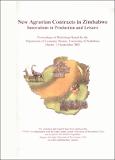| dc.contributor.author | Hughes, David McDermott | |
| dc.coverage.spatial | Southern Africa. | en |
| dc.date.accessioned | 2016-03-21T12:01:27Z | |
| dc.date.available | 2016-03-21T12:01:27Z | |
| dc.date.issued | 2002-09-13 | |
| dc.identifier.citation | Hughes, D.M. (2002) When tourists cross boundaries and peasants don’t: inequality and regional metaphors in the Great Limpopo Conservation Area. In: McDermott Hughes, D. (ed.) New agrarian contracts in Zimbabwe: innovations in production and leisure: proceedings of workshop hosted by the Department of Economic History, University of Zimbabwe, 13th September. Harare: DEH, pp. 114-136. | en |
| dc.identifier.uri | https://opendocs.ids.ac.uk/opendocs/handle/20.500.12413/10178 | |
| dc.description | A study of sustainable conservation management in Southern Africa with due consideration and diligence for the indigenous communities of the areas involved. | en |
| dc.description.abstract | Southern African conservation restricts the mobility of black peasants and enhances the mobility of white tourists. Nowhere is this inequality more evident than in plans for a vast, trans-boundary conservation area known as the Great Limpopo. The scheme would open borders for animals and visitors while confining smallholders to small locales. How have well-meaning conservationists come to promote such a biased, structurally racist set of ideas? Disguising this bias, the Great Limpopo relies upon convoluted assumptions regarding space and time. For space, supporters of the Great Limpopo have elaborated two scales for planning and social intervention. The scheme conjures a Cape-to-Cairo bio-region and landscape of leisure, the African scale for tourists. For peasants, the same planners - especially in Zimbabwe - have crafted an intensive, place-based model of development. White tourists will expand across the African continent whereas black smallholders should involute in “communities.” Yet, within in geographical scale, each group will gain in freedom and power. This false of sense of equality extends from space to time. Southern African bio-regional thinking looks to the future, imagining wildlife ranges and and profitable hotels where neither currently exists. In anticipation of unseen growth, policy-makers open borders for the tourist trade. Meanwhile, the same planners ignore the obvious peasant future of growing populations. Assuming stasis, planners close boundaries and enclose the landscape. Such untenable notions have already been overtaken by events, especially in Zimbabwe, where tourists are now afraid to travel and para-military bands destroy fences. It is time to rethink transboundary conservation in the Great Limpopo and elsewhere. | en |
| dc.description.sponsorship | Funding for this study was provided by the United States Agency for International Development (though the BASIS program of the Land Tenure Center, University of Wisconsin), by Rutgers University, and by the Social Science Research Council (through a MacArthur Foundation-funded NGO summer fellowship). The Southern Alliance for Indigenous Resources and the University of Zimbabwe’s Department of Economic History arranged the logistics without which no work could have been done. | en |
| dc.language.iso | en | en |
| dc.publisher | Department of Economic History; University of Zimbabwe | en |
| dc.rights.uri | http://creativecommons.org/licenses/by-nc-nd/3.0/ | en |
| dc.subject | Environment | en |
| dc.subject | Rural Development | en |
| dc.title | When tourists cross boundaries and peasants don’t: inequality and regional metaphors in the Great Limpopo Conservation Area | en |
| dc.type | Book chapter | en |
| dc.type | Conference paper | en |
| dc.rights.holder | University of Zimbabwe's Department of Economic History. | en |


